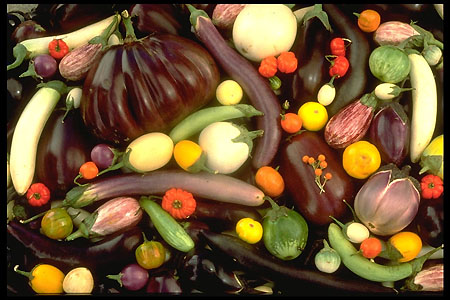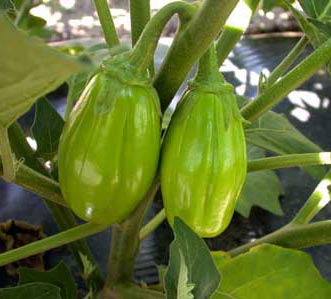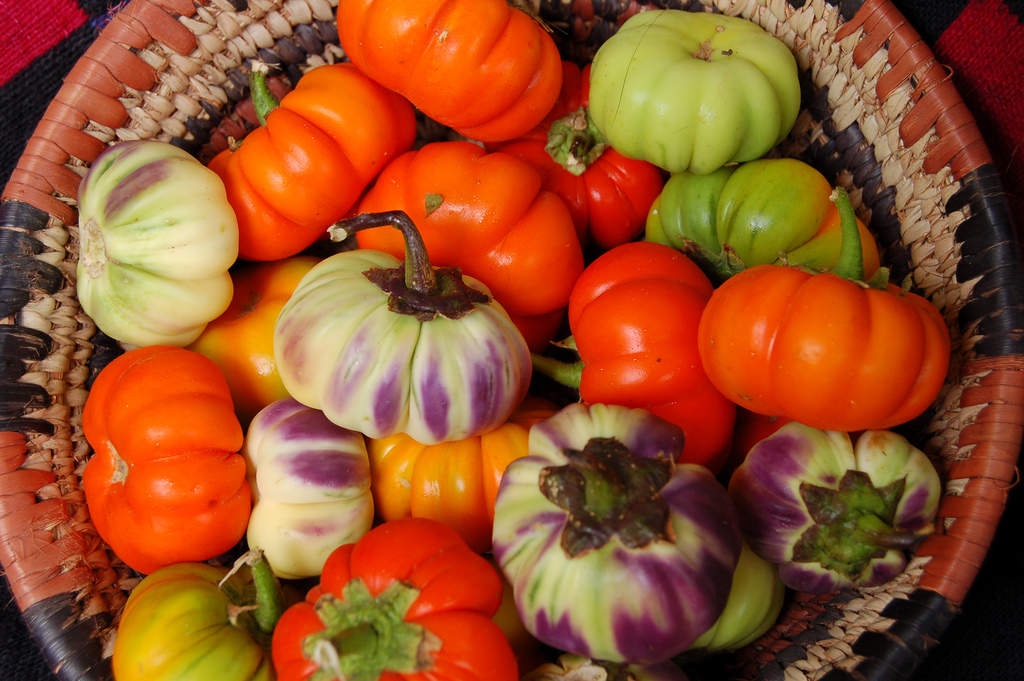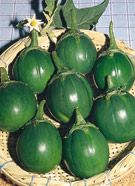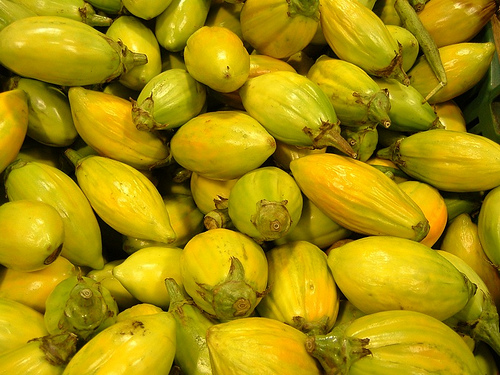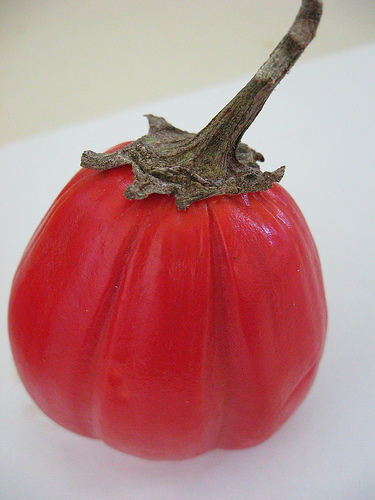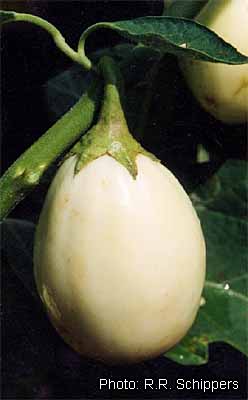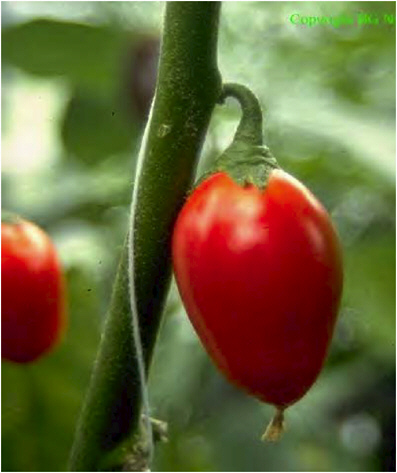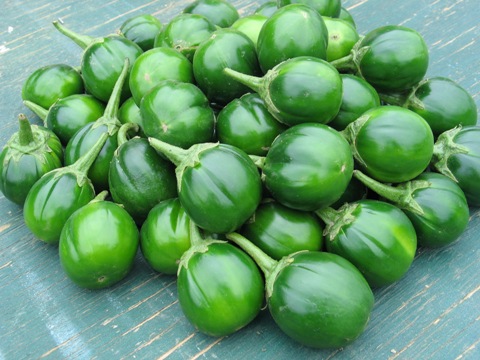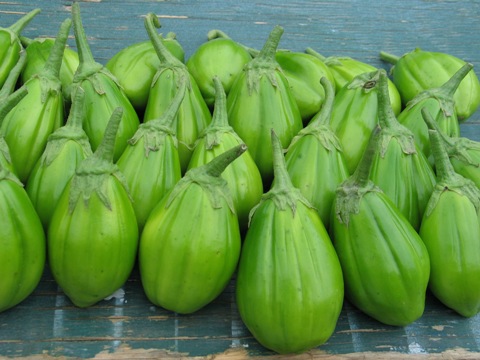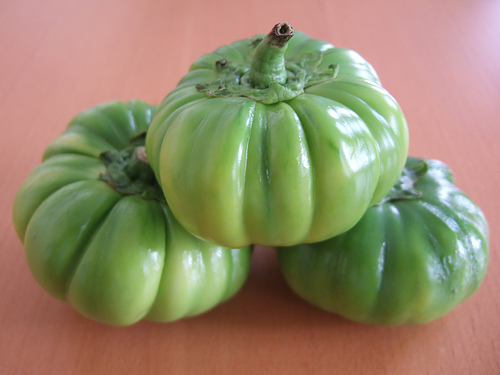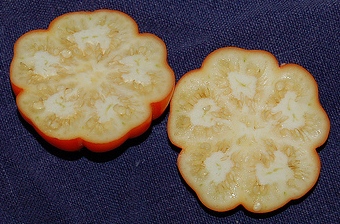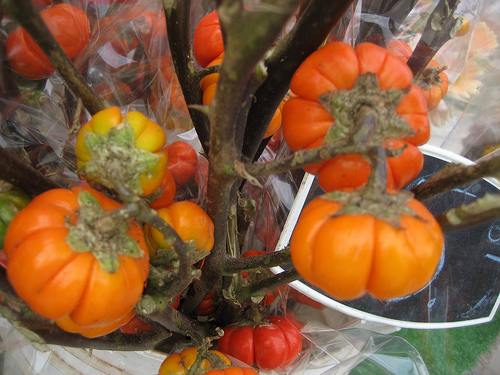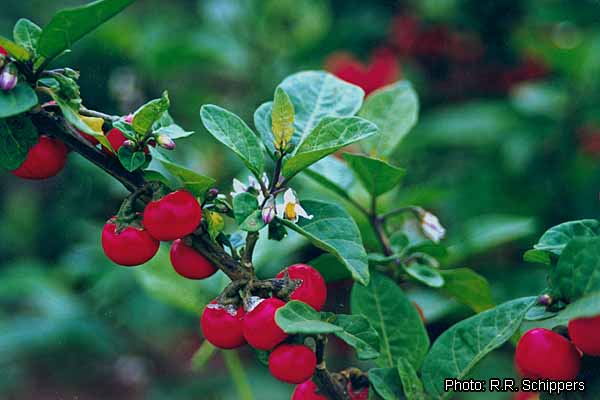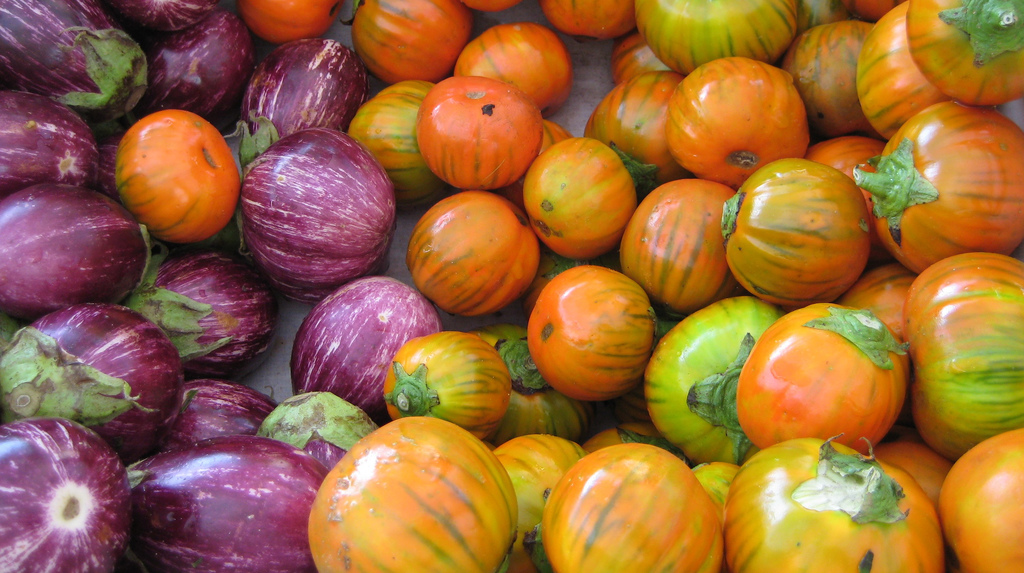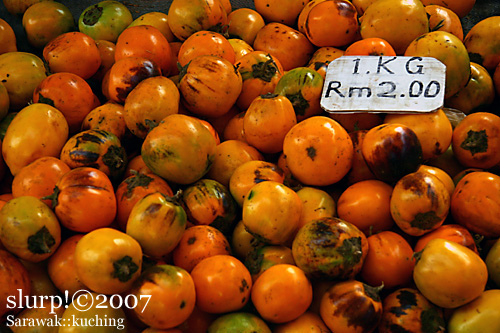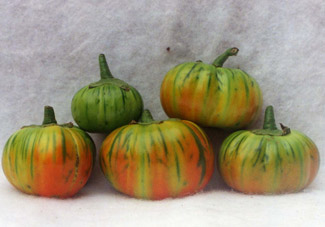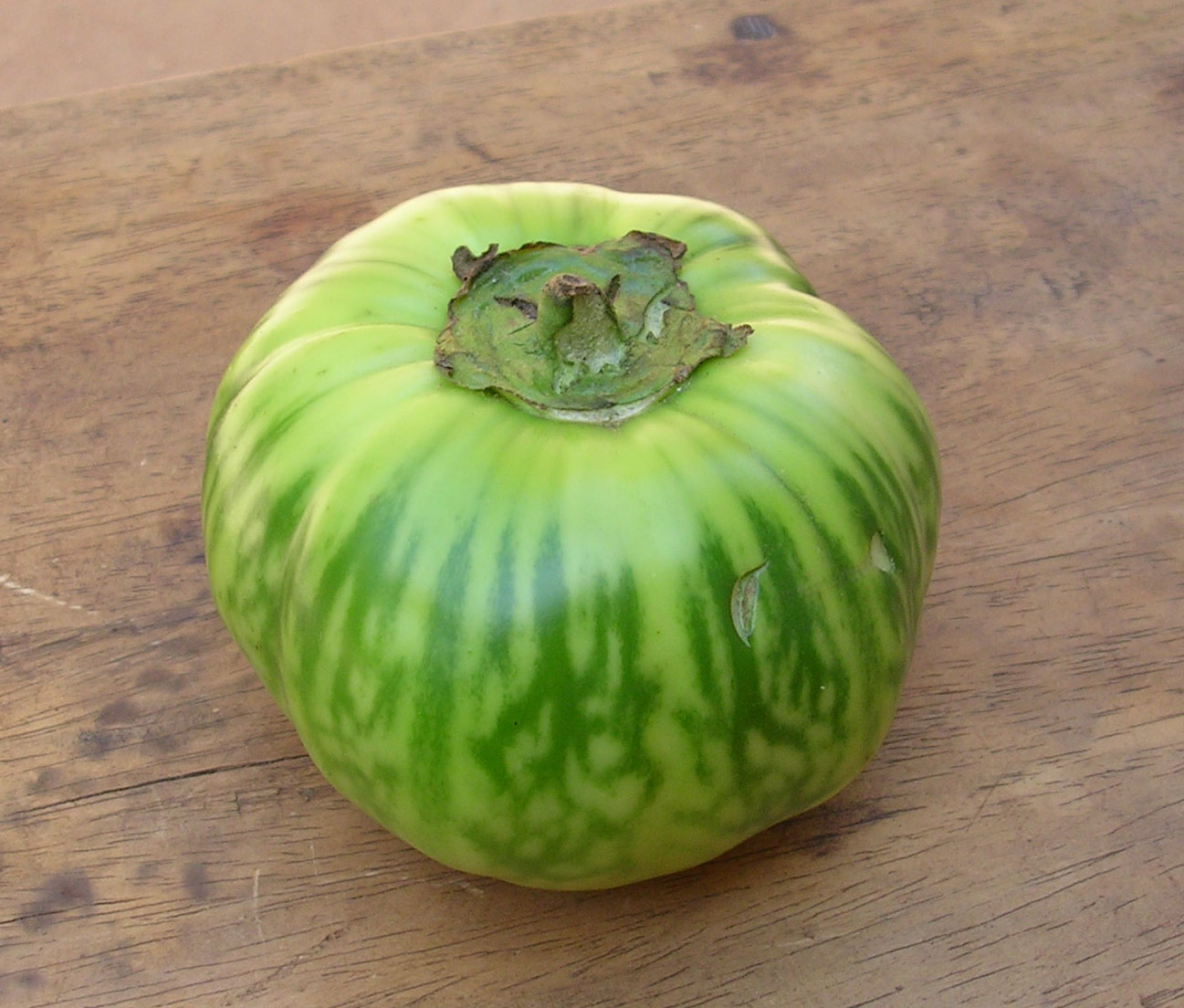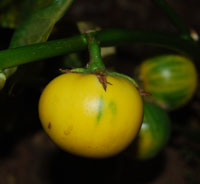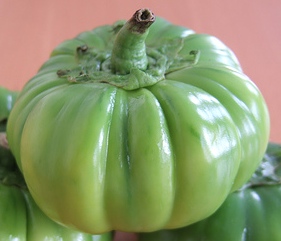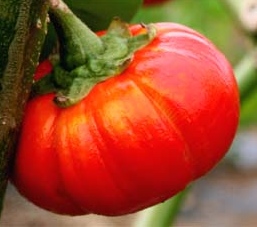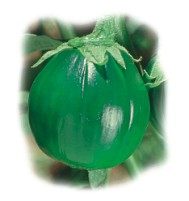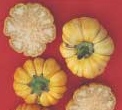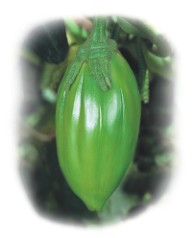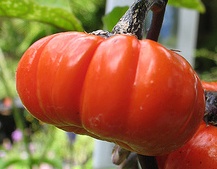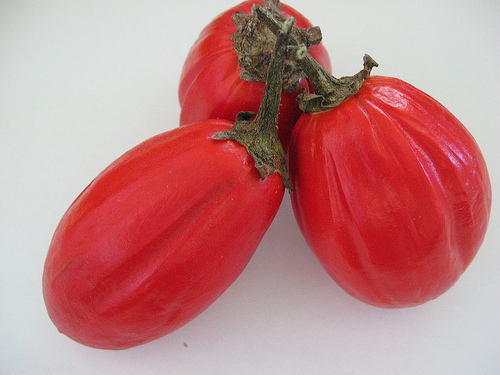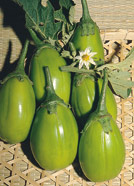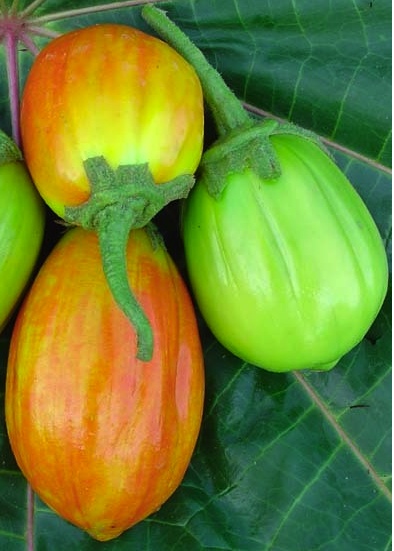Know your eggplants - Part 1

You are here
African
eggplants You are here
The Gilo Group
The
Kumba Group
The Shum Group
The Aculeatum Group
Asian
eggplants
Solanum
melongena
L.
Solanum
torvum
Sw.
Solanum
ferox
L.
Appendixes
African - English
Japanese
-
English
Malay - English
Thai - English
Cultivar descriptions and seed sources tables
African
eggplants
Asian
eggplants

To
those of us living with plants it is always a source of amazement that
eggplants
are so little known. Asian and African consumers know theirs well but
are less
familiar with the Western types. Westerners are equally
ignorant of
the richness found in Asia and Africa. It is even arguable that they
are not
aware of the rich diversity available within the most popular species
(Solanum
melongena
L.) and that
could be available on the market place.
This is understandable because apart from the large purple fruit that everyone knows, very little else is seen in market stalls or on the supermarket shelves. This is not confined to eggplants, it applies to every crop grown and distributed via the market place which, despite the "global village" and the "global market" concepts, remains a market of rather narrow minded traders and consumers. This may be enough to meet the needs of the best known recipes of the Western world such as the Greek “moussaka”, , the French “ratatouille”, the Sicilian “caponata”, the Middle Eastern “baba ghanoush” and “imam bayaldi” But what if one wants to cook the dish from Cameroun “nkwi”, or a “แกงเขียวหวานไก่” Gaeng kĭeow wăan gài (Thai green chicken curry) calling for pea eggplants (European green peas not being an option), the Indian dish धूम्रपान बैंगन करी Baingan ka bharta, the Caucasian Nigvziani badrijani (walnut-flavoured eggplants), the Chinese dish 釀茄子(stuffed eggplants), or even the regional Italian "Fusilli al filetto di melanzana rossa e Caciocavallo Podolico" and "Frittelle di foglie di melanzana rossa" both calling for 'Melanzana Rossa di Rotonda' which is a direct descendant of the African red eggplants?
Some seed companies go to great lengths to make available to their customers a wide range of cultivars (cultivated varieties), but unless people grow the plants, they are not likely to come across some of the most beautiful eggplants available on this planet.
So let us see if we can enthuse some of our readers for some lesser known treasures of the eggplant world.
|
|
|
Reproduced with permission from the copyright owner: David Cavagnaro . |
This
brilliant display encompasses most of the shapes and colours (but not
all)
available in the world. The species and mostly the cultivar names will
vary
greatly in the market place but the basic array will be found. These
fruits
from open-pollinated varieties were all grown by David during his
gardening
days with the Seed Savers
Exchange USA. Most are still preserved and
offered by
this organization. It is also possible to find seeds of hybrid forms of
all these.
We are
not fans of hybrids but during a lack of O.P. cultivars they can fulfil
a need.
They can also be useful if they have been bred to resist specific
climatic
conditions or some diseases. We do not see the need at all for
genetically
modified varieties however. Who would, given the broad spectrum covered
in this
article? It would take the average gardener a lifetime to grow and cook
them
all in the various ways they are meant to be prepared. Some seed
companies do see the need though. Possibly the first
to have this
dubious honour is India
Maharashtra Hybrid Seeds
Company
(Mahyco) based in Jaina, India. Note1
The Tomato
Growers
Seed Supply Company
offers one the widest range of cultivars available in the world
from a single source via a
beautiful
gallery with high quality photos (check the large sizes).
The main difference between the western types of eggplants and the African or Asian is that the first are well and truly domesticated, some would argue too much hybridised if not yet genetically manipulated (except above example). The Asian and African eggplants are much less domesticated for the most part and are either close to their wild relatives or just plain wild plants such as the pea eggplant from Uganda or the hairy-fruited pea eggplant from Thailand.

African
eggplants
are
not
so diverse in shapes or even sizes but their glossy-skinned
fruits can
be found striped, multi-coloured, or in many shades of white, cream,
yellow,
green, lime, orange, pink, red, plum, burgundy, lavender, violet,
purple, and
dusky black. The red-fruited varieties are the favorite in most of the
non-African world. All these colours are developing on mature mostly
inedible
fruits. Generally in order to be edible the fruits are better picked at
an
early stage of development, even more so than is the case with western
types of
eggplants. Looking at photos of the
fruits can be misleading. These eggplants are actually
rather small. See the
photo on top of this page where tiny red fruits rest among giants of
different colours, or the measured size for various cultivars in the
table
below. Apart from a source of food, eggplants in general, African
eggplants
in particular, are also used for medicinal purposes in both a
traditional and
modern sense. Targeted diseases are, among others, diabetes,
bronchitis,
asthma, dysuria, dysentery, etc. We probably raise as many questions as
we answer on this page but that is the nature of knowledge, it keeps on
growing, and these pages are part of the growth.
Gardening note: I am tempted to say that if you are struggling when growing common eggplants in respect to your climatic conditions forget about attempting to grow tropical African or Asian eggplants. Practical experience however has taught me that given the tumultuous climatic conditions that the world is experiencing, no matter where you live, everything is possible. I did grow successfully some red African eggs on a couple of occasions, and yet I have always struggled most years with some common eggplants cultivars and even some tomato cultivars (the reason why I keep on raving about the Italian Pink Pear which has never really failed me).
|
|
|
|
|
A favourite Brazilian Jilo |
Reproduced from flickr with permission from the copyright owner: Veronica Sullivan
The magnificient colours of mature Kumba |
A favourite Brazilian Jilo |
|
|
|
Reproduced from flickr with permission from the copyright owner: Tvindy
"The most hated eggplant
in Brazil" |
The best known African eggplants are the miniature pumpkin-shaped so called "African scarlet eggplant" and the Brazilian Jiló.
They both, together with other groups, come under the domesticated
species Solanum
aethiopicum L., a
species with a rich history. The ancestor of this species
was the wild Solanum
anguivi
Lam. Natural evolution and people influences helping, via the
semi-domesticated
Solanum
distichum
Schumach & Thonn. found in gardens of Tropical Africa, Solanum
aethiopicum L.
was born.
Following further adaptation to different conditions and responding to
various
cultural practices, such as selection for leaves as opposed to
selection for
fruits, the many groups were formed. One group has found its way
to
Brazil via the slave trade. Today Brazilians enjoy it under the name of
Jiló or
Jinjilo. It belongs to the Gilo Group, composed mostly of plants with
elongated
fruits such as those below. Cultivars of a superior quality have
yet to be
identified and / or developed. One of the bodies leading the search and
the
research for the ultimate varieties is the African branch of the Asian
Vegetable Research and Development Center (AVRDC).

Solanum aethiopicum L. (Gilo Group)
|
|
|
|
|
|
'Brazilian Oval Orange' |
A ribbed-red |
A smooth white fruit |
A smooth red fruit |
Within the Gilo Group we find ribbed or smooth fruits, either with white, pale-green, dark-green, striped or purple skin. Cultivars on the market are shown in the following table. Some similar looking cultivars such as "Striped Toga" are listed (under Solanum melongena L.) in various catalogues but we have not been able to find out the parentage. The two main preferred types in Brazil are:
|
|
|
|
Copyrights Maria Moreira (permission sought
20/04/2009) |
Copyrights Maria Moreira (permission sought
20/04/2009) |

Solanum aethiopicum L. (Kumba Group)
|
|
|
Reproduced from flickr with permission from the copyright owner: cia_b
Green fruits ready for picking before the bitter taste develops. |
Plants of this group can be found in catalogues under the synonyms "Red African eggplant", "Orange African eggplant", "Scarlet African eggplant", and even "Mini pumpkin tree". It is often treated as an ornamental in the West because it is strikingly beautiful but also because from a culinary perspective it does not meet the taste of every westerner. Much of the negative feelings towards it are based on ignorance of the basic preparation. The fruits are best picked green, before they start colouring and developing seeds - a general rule applying to all eggplants.
|
|
|
|
Reproduced from flickr with permission from the copyright owner: Veronica Sullivan Inside a maturing fruit |
Reproduced from flickr with permission from the copyright owner: Joel Ignacio Inside an almost mature fruit showing seeds forming. The finger tips give an indication of the size of Kumba |
Dominique Guillet
from Kokopelli
mentions the variety 'Burkina Faso'.
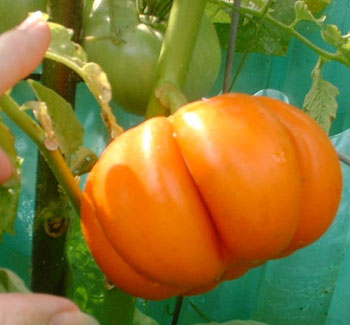
It is available
from both Kokopelli and Amishland Seeds.
According to the
trade there are some sweet cultivars and some bitter
cultivars, although there is no unanimous opinion on the subject. In
fact many
cultivars can be both either sweet or bitter, depending on the growing
conditions and the picking time. There is a cultivar called 'Black
Stream' with
black stems
and orange to red fruits which is grown as an ornamental in France.
Amishland Seeds in America retail what they call "Gilo
Black Stem". This could be a synonym of the same cultivar. They
confirm the ornamental value of the plant as well as the odd tasting /
non edible quality of the fruit. On the other hand the name suggest a
plant from the Gilo Group, which is not unreasonable since some gilos
have round fruits.
Some edible cultivars are grown for their leaves, others for their fruits, and yet others for both (see descriptions in table below).
Unlike the pretty fruits in the photo above many edible African eggplants are not so attractive and look more like the fruits below:
|
|
|
Reproduced
with
permission
from the copyright owner Technisem
Seeds |
The cultivars not available from the sources mentioned in the table below can possibly be tracked down via the African Seed Trade Association.
|
|
|
Reproduced from flickr
with
permission from the copyright owner: Serenity
Forbes
The
reasons for the American name "Mini Pumpkin tree"
(note the long prickles on the main stem) |

Solanum aethiopicum L. (Shum Group)
The cultivars within this group are grown for their leaves. The little bite-size fruits although edible when ripe are often neglected. We could not find any cultivar from this group. Perhaps some of those listed under Solanum macrocarpon L. belong here ?
|
|
|
Reproduced from PROTA article
with
permission from the copyright owner: Rudy
R.
Schippers
Typical
Shum
fruits.
|

Solanum aethiopicum L. (Aculeatum Group)
This
is a group of plants with fruits twice as large as those of the
Shum type
but totally neglected from the culinary point of view. One wonders if
their spiny
leaves and stems are a consequence of the neglect or the cause of it.
The size
of their fruits may make them confusable with those of those listed
under Solanum
macrocarpon L.
They can be grown as ornamentals or used as root stock for
tomatoes and eggplants. ‘Iizuka’
has
been
selected
in Japan for this purpose.
In his massive catalogue, Dominique Guillet of Kokopelli lists 'Tingua Verde Claro' and 'Rouge de Chine' (which we think is a synonym of 'Red China') as Solanum aethiopicum L. (Aculeatum Group) cultivars. We cannot be certain but we tend to think that they are rather respectively Solanum aethiopicum L. (Gilo Group) and Solanum aethiopicum L. (Kumba Group). Feedback on this would be greatly appreciated.
|
|
|
Reproduced
from flickr with
permission
from
the
copyright owner: Wolf Asian
round
purple
(Solanum melongena
L.) and Orange eggplants Solanum
aethiopicum L. (Aculeatum
Group) |

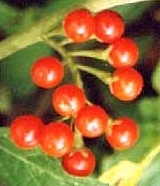
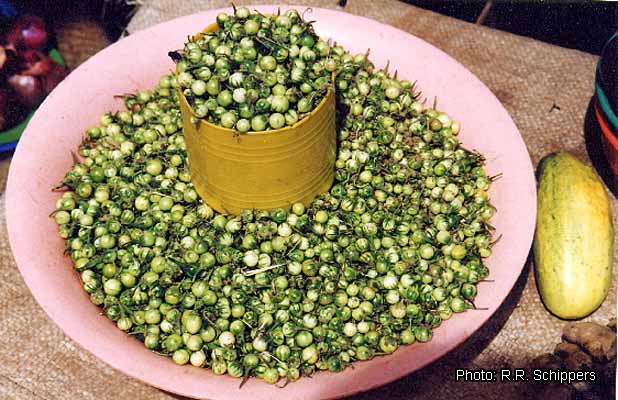  |
| Reproduced from PROTA article
with
permission from the copyright owner: Rudy
R.
Schippers Green Uganda Pea eggplant at edible (but bitter) stage. Grapes of ripe red berries (edible to birds only). |
As a semi-domesticated species it offers a great variation in the plants, flowers and fruits numbers, sizes, colours etc. Worth noting is the Uganda Pea eggplant. The bitter pea-size green fruits are eaten in various ways fresh or dried. In Cameroun they are a vital ingredient of a dish called “nkwi”. They are either picked from the wild plants or grown / tolerated on farms and gardens. In Africa or for African people elsewhere having access to them they are the equivalent to the Asian pea eggplant Solanum torvum Sw.
'Gnangnan' (from Ivory Coast Republic) is a "cultivar" (une forme spontanée!) but most cooks think of it as a "small eggplant". 'Damsah' (Damesah) is possibly a hybrid between Solanum aethiopicum L. (Gilo group) and Solanum anguivi Lam. from the Burkina Faso (formerly called Upper Volta). It bears grapes of small round fruits white to red in colour. Another hybrid of similar parentage is called 'Klongbo'. Little is known about it but evaluations are going on (CNRA, Station d'Anguédédou, Sud de la Côte d'Ivoire - 2008). In fact a relatively new group has been created to reflect the growing number of such hybrids between Solanum aethiopicum L. (Gilo group) and Solanum anguivi Lam. I would call it Solanum aethiopicum L. x Solanum anguivi Lam. (Gilo Anguivi group) but I don't think the Latin part of the name has been formalised yet. Another such hybrid is the African "Aubergine de Ferke" from the Ivory Coast Republic.
|
|
|
Reproduced
from ECPGR Eggplant
Database with permission from Marie-Christine DAUNAY, INRA - France. 'Damsah' |
Propagation of the African eggplants.
From
the seed saver perspective the first thing to keep in mind is that
these plants
are tropical. The second is that all the plants from all species named
above can
cross with each other, produce fertile seeds and therefore in the right
conditions can become weeds. Similarly in non-tropical settings it will
be
equally important to avoid cross-pollination by isolating in the usual
manners:
distance, netting, bagging, spaced flowering if possible etc. This is
not to
avoid propagating weeds but to conserve cultivars true to type as much
as
possible.

|
|
| Reproduced
from flickr
with permission from the copyright owner: Slurp |
This is also known
as the
"African eggplant", sometimes as
"African macrocarpon". A better hybridised name is "Gboma
eggplant" based on its correct African name Gboma.
Gboma (a village from Liberia - West Africa) has
given its name to many
cultivated forms of S. aethiopicum and S. macrocarpon eggplants in West
Africa
and in many coastal countries. It is mostly recognized in relation to
S.
macrocarpon however. Indeed because many cultivars take their names
from
village names there is even a cultivar called 'Gboma' found in Togo but
this being the
common African name for many eggplant types it is really a particularly
misleading
name for
a cultivar.
One could say of this species also that it is semi-domesticated. As such it still has great variations in its growth habit, fruit sizes etc. It is one of the semi-wild species showing the greatest potential for hybridising. The main reason is that its great diversity could be developed in many directions. The second is that its natural resistance to bugs and diseases could improve weaker varieties of the main domesticated species Solanum aethiopicum L. and mostly Solanum melongena L. by crossbreeding.
When cultivated,
varieties are selected for their fruits, usually the thin skinned are
preferred, or their leaves. Both fruits and leaves are bitter and most
need to
be consumed locally. This can only be an advantage from the ecological
viewpoint - no storage - no transport to the other side of the world.
If the
rest of the world wants it, it has to grow it or does it? Despite the
ordinary
quality of the crop some enterprising countries have managed to develop
some
thick-skinned fruits that will store and travel. Senegal and Ouganda
export to
France (the Château-Rouge
market and surrounding shops in
the heart of
Paris
would be a first port of call), San Domingo and Surinam export to the
USA. Not
a promotion of the best that Africa has to offer but a back door entry
for
planting material for seed savers and enterprising horticulturists.
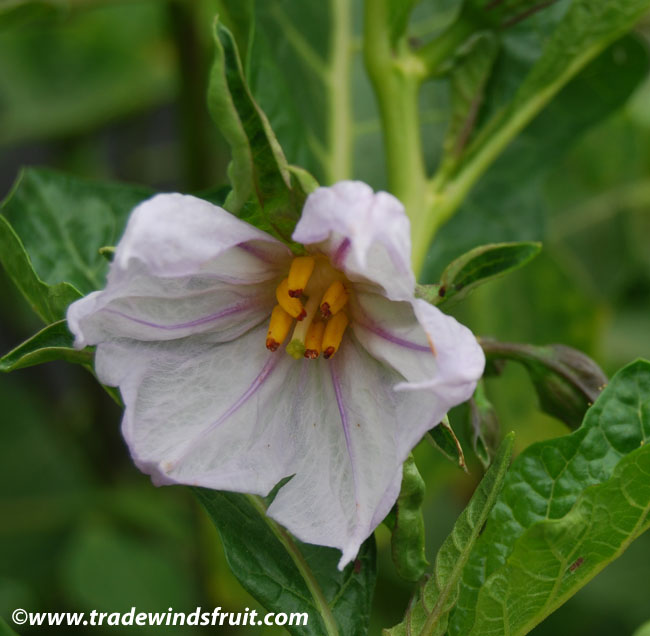
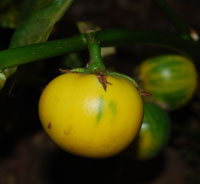
Reproduced with permission from Trade Winds Fruits
Solanum macrocarpon L. 'Gbogname' fruit
Its edibility is not known. Only the young foliage of this plant is consumed in Togo.
There are 4
groups recognized within this species (Bukenya
and Carasco - 1994). We have slotted some cultivars in some of those
groups (see table below).
Solanum macrocarpon Poir. (Mukono Group)
Named after the Town
and cultivar Mukono.
Solanum macrocarpon Poir. (Nabingo Group)
Named after the
Town and cultivar Nabingo.
Solanum macrocarpon Poir. (Semi wild Group)
Synonym: Solanum dasyphyllum Thonn. ex Schum.Solanum
macrocarpon
Poir. (Uganda
Group)
One cultivar called 'Gbokouman', from The Southern Ivory Coast, is reported within this species, but little is known about it. Another with unknown / unclear taxonomy is 'Cookstown Orange'.
|
|
|
|
Reproduced with
permission from copyright owner Elia Woods |
Reproduced
with
permission
from copyright owner Jeffrey
Heath. |
|
Maturing
African
eggplants
'Cookstown Orange' |
Close-up
of
a
green "Bobo eggplant"
aka "Aubergine des Bobos" from
Burkina
Faso |
These seemingly different fruits are in fact of the
same species and probably the same cultivar. The question remains
which? We are tempted to narrow it down to
2: Solanum aethiopicum L. or Solanum macrocarpon L. If it is S.
aethiopicum is
it from the Aculeatum Group or any
other group? Jeffrey Heath et al. give a few African
names for this plant but unfortunately, as it is the case
almost in every
such situation those vernacular names are also given to other species
from the same
countries. Will Jeffrey et al. come up with the answer in their major
project."Dogon and Bangi Me
Linguistics" or
will we?
Meanwhile
this eggplant is available from Sand
Hill
Preservation
Center . It is
described by various sources as:
"Green fruits rather bitter with
dark green stripes when young and edible. Green-orange with faint
dark-green stripes when ripe. Transplantation to first picking in 70
days."

African cultivars on the world market
We have done our best trying to identify every cultivar mentioned. If we have made mistakes please tell us. We have not discriminated between so called organic source of seeds and others in order to offer the broad spectrum of what is available in the world. Again if we missed something please tell us, we will update this table promptly.
This is not a print publication but a live interactive guide. Comments are very welcome
send mail to m.porcher@unimelb.edu.au
Disagreements on botanical names
'Tingua Verde Claro' is considered by Kokopelli as a Solanum aethiopicum L. (Aculeatum Group). We think it is a Jilo so have placed it in that group. They also list 'Rouge de Chine', which we think is a synonym of 'Red China', as a Solanum aethiopicum L. (Aculeatum Group). We tend to think that it is rather in the Kumba Group.
|
Botanical identification (proposed) |
Cultivar name / Vernacular name |
Descriptive info. (various sources) |
Photo of cultivar or type if available |
|
|
|
|
|
|
Solanum macrocarpon L. |
‘Akwaseho’ |
Fruits and leaves are consumed. From Ghana. |
|
|
Solanum aethiopicum L. (Gilo Group) |
‘Brazilian Oval Orange’ |
Available : Baker Creek Heirloom Seeds |
|
|
Solanum macrocarpon L. |
‘Bui’ |
Fruits only are consumed. From Ghana. |
|
|
Solanum aethiopicum L. (Gilo Group) |
‘Comprido Cachoeira’ |
Elongated fruits vary from 20 to 50g per fruit. |
|
|
Solanum aethiopicum L. (Gilo Group) |
‘Comprido Grande Rio ’ |
8 -10 cm thick fruits 80 - 100 g. Elongated form of Verde Claro from Minas Gerais, Rio de Janeiro. Available : SAKATA Seed
Sudamerica Ltda. |
|
|
Solanum aethiopicum L. (Gilo Group) |
‘Comprido verde claro ’ aka ‘ Comridio verde ’ (misspelt) |
Tear-drop light green fruit about 1/4 of the size of a medium size eggplant. From Minas Gerais, Rio de Janeiro & Espirito Santo. Available :
Possibly from Johnny's Selected Seeds. |
|
|
Solanum aethiopicum L. (Gilo Group) x Solanum anguivi Lam. |
‘Damsah’ |
Pea size fruits. From Burkina Faso (Upper Volta). |
|
|
Solanum aethiopicum L. (Kumba Group) |
‘Dwomo’ |
Egg-shaped fruits. From Ghana. |
|
|
Solanum macrocarpon L. |
‘Gbogname’ |
Ancient
vegetable from Togo, West Africa. Its young green leaves are cooked but
the green to yellow bitter fruits (2.5 to 3 inches - 7 to 8 cm in
diameter) are ignored. These may be edible young. |
|
|
Solanum macrocarpon L. |
‘Gboma’ |
Fruits and leaves are consumed. From Ghana. |
|
|
Solanum aethiopicum L. (Kumba Group) |
‘Goyo Kumba’ |
Available
: Kokopelli, Tradewinds |
|
|
Solanum macrocarpon L. |
‘Igbagba’
|
From Nigeria. |
|
|
Solanum aethiopicum L. (Kumba Group) |
‘Jaxatu
Soxna’ aka 'Soxna' |
|
|
|
Solanum macrocarpon L. |
‘Kade’ |
Fruits and leaves are consumed. From Ghana. |
|
|
Solanum macrocarpon L. |
‘Mankessim’ |
Fruits and leaves are consumed. From Ghana. |
|
|
Solanum aethiopicum L. (? Group) |
‘Manyire Green’ |
Round, green ripening to red fruits. From East Africa. |
|
|
Solanum aethiopicum L. (Aculeatum Group) Synonym : Solanum integrifolium Poiret |
‘Melanzana Rossa di Rotonda’ aka ‘Merlingiana a Pummadora’ aka ‘Italian Orange’? |
Brought from Africa and grown since the late1800's in Rotonda - Italy and claimed with justification as an Italian Heirloom. Available : Italian private growers. |
|
|
Solanum aethiopicum L. (Gilo Group) |
‘Morro Grande Verde-Escuro’ aka 'Dark Green Morro Grande’ |
Dark-green
larger round or oblong fruits 6 - 7 cm diameter, 80 - 100 g .
From São Paulo. 110 - 130 days. Available : ISLA, SAKATA Seed Sudamerica Ltda. |
|
|
Solanum aethiopicum L. (Gilo Group) |
‘Morro Redondo’ |
Bitter round dark-green fruits about 1/4 of the size of a medium size eggplant. From São Paulo. Available : Possibly from Johnny's
Selected Seeds. |
|
|
Solanum macrocarpon L. (Mukono Group) |
‘Mukono’ |
see African Seed Trade Association |
|
|
Solanum aethiopicum L. (Kumba Group) |
‘N’Drowa Issia’ |
Sweet fruits 5 cm diameter 70 - 80 g. From Ivory Coast. Available : Graines Baumaux |
|
|
Solanum aethiopicum L. (Kumba Group) |
‘N’Drowa’ |
Non bitter yellowish- green slightly ribbed fruits on very vigorous plants. 55 - 60 days. Available : Technisem |
|
|
Solanum aethiopicum L. (Kumba Group) |
‘N’Galam’ |
Slightly bitter Light-green to white fruits, variable in size according to conditions.120-180 g. 65 - 75 days. Available : Technisem |
|
|
Solanum aethiopicum L. (Kumba Group) |
‘N’Goyo’ |
Bitter dark-green fruits, variable in size according to conditions. 70-120 g. 60 80 days. Available : Technisem,
Graines Baumaux |

|
|
Solanum macrocarpon L. (Nabingo Group) |
‘Nabingo’ |
see African Seed Trade Association |
|
|
Solanum aethiopicum L. (Gilo Group) |
‘Português ’ |
8 -10
cm thick fruits 80 - 100 g. From Minas
Gerais, Rio de Janeiro. 110 - 130 days. Available : SAKATA Seed
Sudamerica Ltda. |
|
|
Solanum aethiopicum L. (Kumba Group) |
‘Red China’ aka ‘Scarlet Chinese’ aka ‘Rouge de Chine’ |
Fruits 0.75 to 1 inches long by 2
to 2.5 inches wide.
Mildly bitter at orange stage, too bitter for most tastes when red.
Spiny plant. 50days. |
|
|
Solanum aethiopicum L. (Gilo Group) |
‘Red Egg’ |
Available : Graines Baumaux |
|
|
Solanum aethiopicum L. (Kumba Group) |
‘Red Ruffled’ aka ‘Hmong Red’ |
2 inches fruits |
|
|
Solanum aethiopicum L. (? Group) |
‘Red Skin’ |
Available : Eden Seeds |
|
|
Solanum macrocarpon L. |
‘Sarpeiman’ |
Fruits only are consumed. From Ghana. |
|
|
Solanum aethiopicum L. (Kumba Group) |
‘Small Ruffled Red’ |
Small, deeply creased fruits, about 5 cm in diameter, with orange-red skin, 2" fruits are born in clusters on 20" plants. Fruits are bitter, but used extensively in Asian cuisine. Available : Seed Savers Exchange. |
|
|
Solanum aethiopicum L. (Gilo Group) |
‘Sodefel’ |
A cultivar from the Ivory Coast. |
|
|
Solanum aethiopicum L. (Gilo Group) |
‘Striped Nigerian’ |
Fruits are described as oval-shaped striped with green and red. From Nigeria. |
|
|
Solanum aethiopicum L. (Kumba Group) |
‘Super N'Drowa’ |
Sweet ivory-white round fruits on very vigorous plants. 55 - 60 days. Available : Technisem |
|
|
Solanum aethiopicum L. (Gilo Group) |
‘Sweet African Egg’ aka ‘Sweet African Orange’ |
4 inches (10 cm) oval or round fruits maturing from white to shiny orange-red. on plants 2.5 feet (76 cm) tall.90 days. Available : Terroir Seeds LLC. |
|
|
Solanum aethiopicum L. (Aculeatum Group) Synonym : Solanum integrifolium Poiret
|
‘Sweet Red ’ aka ‘Sweet Orange’ |
Small, attractive fruits, about 2.5 cm in diameter, green skinned with dark-green stripes, turning red with dark-red stripes at maturity, Available : no known source. |
Seems to have disappeared. We could no longer find it on the market. |
|
Solanum aethiopicum L. (? Group) |
‘Tengeru White ’ |
Round, half green, half white fruits. |
|
|
Solanum aethiopicum L. (Gilo Group) |
‘Tinguá’ aka ‘Tingua Verde Claro’ aka ‘Jiló Tinguá Verde Claro’ |
Plant is heavy yielder. Fruits consumed green, mature to orange and red. From Minas Gerais, Rio de Janeiro Available : Baker Creek
Heirloom Seeds, Kokopelli, ISLA |
|
|
Solanum aethiopicum L. (Aculeatum Group) Synonym : Solanum integrifolium Poiret |
‘Turkish Orange’ aka ‘Orange de Turquie’ aka ‘Italian Orange’ Probably not a true synonym |
Orange spherical fruits, 6 cm in diameter to tennis-ball size (2.5 to 3 inches). "Excellent sweet taste" to "Bitter taste" depending on picking time. 80 days to 90 days. 4 foot plants bear 15-25 fruits per plant. Available : Reimer Seeds,
Baker Creek Heirloom Seeds, Seeds of
Change, Chiltern Seeds, Southern
Exposure Seed Exchange, Diggers Seeds Aust., Kokopelli, Amishland Seeds. |
|
|
Solanum anguivi Lam.
|
‘Uganda Pea’ |
Tiny pea size white to green fruits. |
|
Note on the following companies.
A number of those are part of complex corporate structures and are difficult to contact directly. The main address that we give below is a starting point. We are not sponsored by any of those companies nor do we receive any favour from them apart from the odd catalogue photo. It would be nice to be able to link directly to a gallery or a photo or a description but this is sometimes impossible and practice has taught us that these links never last long anyway because online catalogues are updated regularly and URLs change often. The cultivar numbers relate to all seeds not just African eggplants. When neither O.P. or F1 are mentioned one can assume that all seeds are hybrids. Most companies are more likely to carry a mixture of hybrids and open pollinated cultivars. This is an unfortunate but realistic commercial imperative.
Amishland Seeds.
(16 O.P.)
Australian Free Seed Ring .O.P.
Baker Creek Heirloom Seeds . (50 cvs)
British Seeds Ltd.
Japanese page. (26 O.P. cvs)
Chiltern Seeds . (10 O.P. cvs)
Cross Country Nurseries (seedlings). (53 cvs)
Diggers Seeds Aust. O.P.
Graines Baumaux . (17 O.P. cvs) + (12 F1 cvs).
ISLA Sementes Ltda. (3 cvs)
Johnny's Selected Seeds. (17 F1 cvs) + (1 O.P. cv)
Kokopelli . (34 .O.P. cvs)
Reimer Seeds . (62 cvs)
SAKATA
Seed
Sudamerica
Ltda .
( Portuguese
page ).
Sand Hill Preservation Center
(20
O.P. cvs)
Seeds of Change . (11 O. P. cvs)
Seed Savers Exchange . (15 O.P. cvs)
Southern Exposure Seed Exchange . O.P. (11 O.P. cvs)
Technisem . (14 cvs)
Terroir Seeds LLC. otherwise known as Underwood Gardens. (4 O.P. cvs)
Trade Winds Fruit
USA. Edible
(18 cvs), Ornamental (4
spp.)
Appendixes
The
vernacular / common names below are most unreliable. They are given
here to
give hints on "what it could be" but not "what it is". The
purpose of the MMPND
is actually to sort the valid names from the others, a
process that will go on until 2020 and most likely beyond.
A mini lexique of African names
Chungu (Swahili) = African
eggplant (Solanaceous
aethiopicum L.)
Djakattou
= French rendering of Western African name for African eggplant
(Solanaceous aethiopicum L. (Kumba Group))
Djakhattou = French rendering of Western African name for African
eggplant
(Solanaceous aethiopicum L. (Kumba Group))
Diakatu = Solanum incanum L.
Enjagi (Uganda) = Bitter berries ((Solanaceous aethiopicum L. (Gilo Group))
Entula enganda (Uganda) = Bitter berries ((Solanaceous aethiopicum L. (Gilo Group))
Entura (Uganda) = Bitter berries ((Solanaceous aethiopicum L. (Gilo Group))
Gboma = applied to either Solanaceous aethiopicum L. or Solanaceous macrocarpon Poir.
Jagi (Uganda) = Bitter berries ((Solanaceous aethiopicum L. (Gilo Group))
Jakhatou = French rendering of Western African name for African eggplant (Solanaceous aethiopicum L. (Kumba Group))
Jagatú tunga =
Portuguese rendering of African name for African eggplant
(Solanaceous
aethiopicum L.)
Nakati (Uganda) = Leaves of scarlet eggplant (Solanaceous aethiopicum L.)
Nakati nume y'akyalo (Uganda) = (Solanaceous macrocarpon Poir.)
Ngogwe (Swahili) = African eggplant (Solanaceous aethiopicum L.)
Nyanya chungu (Swahili) = African eggplant (Solanaceous aethiopicum L.)
Vergans (Uganda) = (Solanaceous macrocarpon Poir.)
Suggestions, corrections, additions welcome.
Acknowledgements:
I wish to acknowledge the kind cooperation of many colleagues mentioned
throughout this article and mostly all my flickr contacts who have
provided useful comments and many of those beautiful photos. Thank you
very much to
all. This proves once more that with a little cooperation we can
achieve a lot more than with court cases.
References:
***** This is a sign of a great reference.
Agnieszka Sękara, Stanisław Cebula, Edward Kunicki, 2007, Cultivated eggplants – origin, breeding objectives and genetic resources, a review. FOLIA HORTICULTURAE Ann. 19/1, 2007, 97-114. Department of Vegetable Crops Agricultural University in Kraków, Poland. < http://www.ptno.ogr.ar.krakow.pl/Pobrania/download.php?action=save&id=197& cat=fh19012007 >. PDF file. *****
AllPenang.com, 2007, Multilingual List of Vegetables available in the Penang Wet Market. < http://malaysian-cuisine.com/touristinfo/wet_market-vegetables.htm >.
Bukenya, Z. R. and J. B. Hall. 1987. Six cultivars of Solanum macrocarpon (Solanaceae) in Ghana. Euphytica 17(1): 91-5.
College of Agriculture and Life Sciences - Cornell University. Interesting evaluations of most eggplants cultivars on the market by subscribers. < http://vegvariety.cce.cornell.edu/mainSearch/showAll.php?ID=23&sortBy=overallrating&order=DESC&searchIn=1 >.
Elizabeth Byanjeru Rubaihayo, Conservation and use of traditional vegetables in Uganda < http://www.bioversityinternational.org/publications/Web_version/500/ch15.htm >.
Ethiopian Plant Names < http://www.ethiopic.com/aplants.htm >.
Guillet Dominique, 2007, Semences de Kokopelli, 7th Edition. Edition La Voix des Semences. pp.452 - 463.
International
ECPGR
Eggplant
Database.
Botanical and Experimental Garden, Radboud
University Nijmegen, The Netherlands. EGGNET
(EGGplant
genetic
resources NETwork), a project funded by the European
Union.
The project is coordinated by Ms. Marie-Christine Daunay, Unité de
génétique
& amélioration des fruits et légumes, INRA, Montfavet, France. <
http://www.bgard.science.ru.nl/eggnetdb2/
>. See below for more details.
Medicinal
Plants
of
Myanmar. <
http://www.tuninst.net/MyanMedPlants/TIL/famS/Solanaceae.htm#Solanum-spp
>.
M.M.P.N.D. For all nomenclatural details we refer you to our page on Eggplants.
Natural History Museum. Solanaceae Source - A global taxonomic resource for the nightshade family. < http://www.nhm.ac.uk/research-curation/research/projects/solanaceaesource/taxonomy/list.jsp >.
PROTA < http://database.prota.org/ >.
The following reference pages from PROTA contain far more colour photos and details on all aspects of the species treated above. We have considered the information on these pages as our main references because they contain far more details than any other source. *****
Bukenya-Ziraba, R., 2004. Solanum anguivi Lam. [Internet] Record from Protabase. Grubben, G.J.H. & Denton, O.A. (Editors). PROTA (Plant Resources of Tropical Africa / Ressources végétales de l’Afrique tropicale), Wageningen, Netherlands. < http://database.prota.org/search.htm>. Accessed 18 April 2009.
Lester, R.N. & Seck, A., 2004. Solanum aethiopicum L. [Internet] Record from Protabase. Grubben, G.J.H. & Denton, O.A. (Editors). PROTA (Plant Resources of Tropical Africa / Ressources végétales de l’Afrique tropicale), Wageningen, Netherlands. < http://database.prota.org/search.htm>. Accessed 18 April 2009.
Bukenya-Ziraba, R. & Bonsu, K.O., 2004. Solanum macrocarpon L. [Internet] Record from Protabase. Grubben, G.J.H. & Denton, O.A. (Editors). PROTA (Plant Resources of Tropical Africa / Ressources végétales de l’Afrique tropicale), Wageningen, Netherlands. < http://database.prota.org/search.htm>. Accessed 18 April 2009.
Schippers, R.R., 2004. Solanum torvum Sw. [Internet] Record from Protabase. Grubben, G.J.H. & Denton, O.A. (Editors). PROTA (Plant Resources of Tropical Africa / Ressources végétales de l’Afrique tropicale), Wageningen, Netherlands. < http://database.prota.org/search.htm>. Accessed 18 April 2009.
Seeds
/ Plants sources / Useful contacts
African
Seed
Trade
Association
(AFSTA)
P. O. Box 2428 - 00202, Nairobi, Kenya |
Tel; +254 20 2727860/853
Email: afsta@afsta.org
EGGNET
(EGGplant
genetic
resources NETwork).
The seed savers of the world keep trying to design a suitable
database of eggplants (among many other crops) but the existing formal
sites already have such things. It could be argued that these official
dBases are not exactly matching the needs of the average person but one
should be aware of them as references in some circumstances. Two such
web-based databases with search forms are: the EGGNET
related (http://www.bgard.science.ru.nl/WWW-IPGRI/eggplant.htm) and the
Radboud University
Solanaceae database
(http://www.bgard.science.ru.nl/solanaceae), more succint in its
presentation, easier to manage and consult for the average reader. All
these are interlinked so no matter how you approach the network you'll
get access to all the data. In addition, the serious researcher will
find plenty of reference material from these two organisations. The Solanaceae
Literature database from the Radboud University Botanical and
Experimental Garden with its EGGNET
access.
Again
these resources are interlinked with the rest of the
network.
Natural History Museum - London U.K. , Solanaceae Source - Global Taxonomic Resource for the Nightshade Family. by Dr. Michael Nee. A work licenced under a Creative Commons Licence.
Technisem
7 avenue du Garigliano
ZAC des Gâtines
91601 Savigny sur Orge cedex
France
Tel : +33 1 69 96 03 42
Fax : +33 1 69 96 86 01
E-mail : technisem@technisem.com
Technisem Asia Pty Ltd
Stephane Gorin, General Manager
c/o Green Co. 81/10 B Ho Van Hue Street
Dist. Phu Nhuan, Ward 9
Ho Chi Minh City Vietnam
Tel : (848) 8476901
Direct : (848) 8448897
Fax : (848) 8441392
e-mail office : green-co@saigonnet.vn
e-mail pers.: stephanegorin@hotmail.com
e-mail pers.: ptquyen@hcm.vnn.vn
Note 1 Mahyco have produced a BT eggplant (the eggplant is genetically "combined" with a bacterium gene). Bacillus thuringiensis (BT) is a fatal pathogen of a troublesome pest of the eggplant in India and other tropical regions of the world. In sustainable conditions that same bacterium would be spread over the crop. The best example of this is "Dipel". The bacterium in this commercial product is a pathogen specific to the white cabbage butterfly. Closely related bacteria are probably as deadly to other pests. The debate "spraying a biological control versus genetically engineering a crop plant" is purely based on economics and very much in the economic rationalism frame of mind. The future will tell if this is an environmental mistake or not. A photo of this GE or GM eggplant and details in both Hindi & English can be found in this article.
This article "India bans GE eggplant" by Jude
Fanton (23/02/2010) shades more light on the subject.
Compiled by Michel H. Porcher
Started 12 / 04 / 09
Updated 30 / 03 / 10
